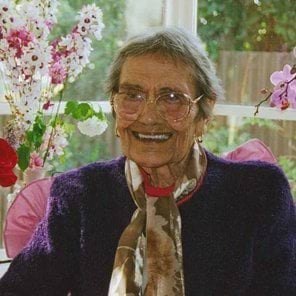
- Inducted:
- 2014
Aunty Edna Brown was a popular Fitzroy identity whose kindness touched the lives of the most disadvantaged. The Gunditjmara Elder was the driving force behind the Aboriginal Funeral Benefits Fund, Victoria's first Aboriginal funeral fund, believing in the right to a dignified burial for her people.
Fitzroy was to be Edna's home for life
Born in Hamilton in 1916, Edna was raised by her parents George Clarke and Mary-Anne (née Lovett McClennan) on the Framlingham Aboriginal Reserve. The family, including Edna's 4 siblings, subsisted largely on what the land provided. Edna would fetch drinking water from the river and walk 2 miles to school in Purnim, often in the freezing cold.
In 1932, at the height of the Great Depression, 15-year-old Edna and her father left Framlingham. In those days, government policy aimed to assimilate Aboriginal people of mixed descent into non-Aboriginal society. Edna and her father came to Fitzroy, an impoverished suburb at the time, where many displaced Aboriginal people gathered. It was to be Edna's home for life. She married James Brown in 1934 and had 4 children. She also raised her sister's daughter as her own.
The family faced many hardships but Edna's strength of spirit and unflagging work ethic always prevailed. To support her children, she worked long hours as a cleaner, including for many years at Melbourne's Customs House. Edna's house was the first stop for countless new arrivals to the city and there was always a meal and a bed for those who needed it. She also helped newly arrived Aboriginal people reconnect with lost relatives and contributed to the sense of community that flourished among the residents of Fitzroy.
Edna strongly believed in the need for a place in Melbourne where her people could be buried together
It was in the early 1960s that Edna witnessed an Aboriginal person being buried as a pauper in an unmarked grave. Sadly, it was a common fate in the absence of money for a proper funeral. From that moment, Edna devoted herself to ensuring that every Aboriginal person would be buried with dignity. When the child of a relative passed away, Edna organised a raffle to raise money for the funeral. Her funeral fund then grew from there.
The success of 'Aunty Edna's funeral fund' was due to its namesake's indefatigable fundraising efforts. As well as raffling donated goods – the artist Lin Onus AM gave many of his paintings to the cause – Edna also organised popular Aboriginal cabarets at venues like Collingwood Town Hall. Friends and family helped to cater and staff these highly anticipated events, and over the years many well-known Aboriginal musicians such as Harry Williams provided the entertainment. The cabarets became important social occasions for the community.
As the fund developed, Edna worked to build partnerships with funeral parlours across Victoria; securing discounts, establishing payment schemes and dealing with coffin manufacturers. She would personally handle funeral arrangements on behalf of families. Many would make monthly contributions to the fund, but those who couldn't afford it were also supported. Eventually a hearse was purchased with the help of another Aboriginal leader Stewart Murray OAM JP. It was proudly emblazoned with the Aboriginal flag.
The funeral fund relied solely on fundraising and received no government support. Only once did Edna seek government assistance, when she and Stewart Murray petitioned for funds to purchase land in Fawkner Cemetery. Edna strongly believed in the need for a place in Melbourne where her people could be buried together. The request was denied, however many years later Edna's niece Lorraine 'Bunta' Patten rediscovered Edna's letter and led negotiations that resulted in the establishment of Weeroona Aboriginal Cemetery at Greenvale – the spiritual successor to Edna's funeral fund.
Edna's ability to unite people came to the fore
Outspoken and honest, Edna was a much-loved figure in the Fitzroy community and a vocal supporter of Aboriginal rights, from the campaign that brought success at the 1967 referendum to the subsequent push for Aboriginal self-determination. As Aboriginal people increasingly took charge of their own interests, Edna's ability to unite people came to the fore. She had time for everyone and was particularly fond of the homeless men who spent their days in Fitzroy's parks and laneways. She was also a faithful supporter of the Fitzroy Stars Football Club.
Edna was proud to be associated with the Victorian Aboriginal Health Service (VAHS), which she helped establish with her daughter Alma Thorpe in 1973 (Alma was inducted to the Victorian Indigenous Honour Roll in 2011). From the beginning, when she laboured to prepare its derelict first home, Edna was integral to the running of the organisation. She volunteered her time as cleaner and patient liaison, always on hand with a pot of tea and some insightful words of advice. Edna was a fixture at VAHS for more than 25 years and her contribution was acknowledged with the opening of the Edna Rose Brown Elders Memorial Healing Garden in 1997.
In 1986, Edna was named NAIDOC Aboriginal of the Year, in recognition of a lifetime devoted to her people. She went on to help Aunty Iris Lovett-Gardiner establish Aboriginal Community Elders Services in 1987. She travelled Australia and remained politically engaged, attending the bicentennial protests in 1988. Her colourful knitted blankets became treasured possessions to many.
Aunty Edna passed away in 2006, having given so much to so many. She often said she learnt something new every day of her life. Now her spirit lives on in her many descendants, who continue to be inspired by the values Aunty Edna lived by.
Updated

